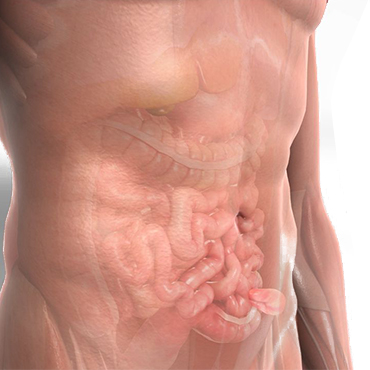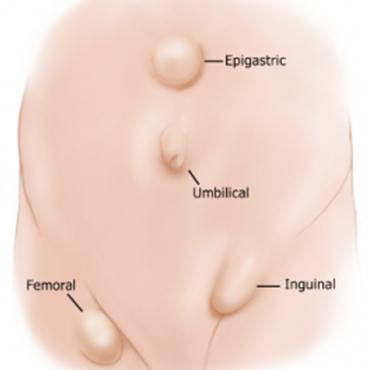laparoscopic-hernia-surgery
WHAT IS A HERNIA?
A hernia occurs when an internal organ protrudes through a weak area of muscle. They commonly occur in the groin, belly button and the site of a previous operation.
A hernia can happen at any age. You may be born with a hernia (congenital) or develop one over a period of time. Both men and women can get a hernia.
You may notice a bulge under the skin or feel a sharp and immediate pain when lifting or coughing or a dull ache that gets worse towards the end of the day.
Hernias can only be repaired with surgery. A hernia does not get better over time, nor will it go away by itself.
THERE ARE THREE TYPES OF HERNIA:
- An uncomplicated hernia or reducible hernia is where the intestines bulge into the peritoneum (the membrane lining the abdomen). It can still be manipulated back into the body although it will not stay in place without corrective surgery. It is recommended that an uncomplicated hernia be repaired as there is a danger of it becoming incarcerated or strangulated.
- An incarcerated hernia occurs when the intestines bulge through the hernia area and become trapped.
- A strangulated hernia is when the blood supply to an incarcerated hernia is cut off. Strangulated hernias can result in gangrene.
- Both incarcerated and strangulated hernias require emergency surgery. Severe, continuous pain, redness and tenderness are signs that the hernia may be incarcerated or strangulated. It is important to contact your doctor if you have any of these symptoms.


HERNIA REPAIR SURGERY
There are two types of hernia repair surgery:
- Open Surgery – This is where the surgeon makes an incision into the area of the hernia and the uses a small piece of surgical mesh to repair the defect or hole. This technique may be performed using a spinal or general anaesthetic, but occasionally can be performed under local anaesthetic with sedation.
- Keyhole or laparoscopic surgery – This is where a tiny telescope connected to a camera is inserted through a small port, allowing the surgeon to see the hernia and surrounding tissue on a television screen. Other small ports are inserted into the lower abdomen to allow the surgeon to insert fine laparoscopic instruments into the abdomen in order to repair the hernia. A piece of surgical mesh is placed over the hernia and held in place with small surgical staples.
Keyhole surgery is not suitable for all patients.
ADVANTAGES OF KEYHOLE SURGERY
- It may offer a quicker return to work and normal activities
- It may cause less post-operative pain
- Other hernias that are not yet visible can be identified and repaired at an earlier stage so that you won’t have to return for more surgery.
- It has better cosmetic results. There are 3 small scars rather than a 6-8 centimetres long scar.
WHO IS SUITABLE FOR LAPAROSCOPIC SURGERY?
Your surgeon will be able to inform you after a thorough examination if this is he right procedure for you. It might not be best if you have had previous abdominal surgery, or underlying medical conditions.
WHAT PREPARATION IS REQUIRED?
- Most hernia operations are performed on an outpatient basis, and therefore you will probably go home on the same day that the operation is performed.
- Preoperative preparation includes blood tests, medical evaluation, chest x-ray and an electrocardiogram, depending on your age and medical condition.
- After your surgeon reviews with you the potential risks and benefits of the operation, you will need to provide written consent for surgery.
- It is recommended that you shower the night before or morning of the operation.
- If you have difficulties moving your bowels, an enema or similar preparation may be used after consulting with your surgeon.
- After midnight the night before the operation, you should not eat or drink anything except medications that your surgeon has told you are permissible to take with a sip of water the morning of surgery.
- Drugs such as aspirin, blood thinners, anti-inflammatory medications (arthritis medications) and Vitamin E will need to be stopped temporarily for several days to a week prior to surgery.
- Stop smoking and arrange for any help you may need at home.
WHAT HAPPENS IF THE OPERATION CANNOT BE PERFORMED LAPAROSCOPICALLY?
In a small number of patients, the laparoscopic method cannot be performed. Factors affecting the increased risk of an open procedure may include obesity, a history of previous abdominal surgery causing scar tissue, inability to visualise organs or bleeding problems during the operation.
The decision to perform the open procedure is a judgement decision made by your surgeon either before or during the actual operation. When the surgeon feels that it is safest to convert the laparoscopic procedure to an open one, this is not a complication, but rather a sound surgical judgement. The decision to convert to an open procedure is strictly based on patient safety.
COMPLICATIONS
Complications are unexpected problems that can occur during or after the surgery. Most patients do not experience any problems after surgery but complications that may occur include:
- Bleeding – this is very uncommon with laparoscopic surgery.
- Infection – you may get an infection in the wound caused by the mesh or sutures/staples. This is a very rare complication.
- Slight risk of injury to the bladder, intestines, blood vessels, nerves or the sperm tube going to the testicles.
- Difficulty urinating after surgery is not unusual and may require a temporary tube into the bladder.
- At any time a hernia can come back. The long-term recurrence rate is not known.
WHAT TO EXPECT AFTER SURGERY
- Following the operation, you will be transferred to the recovery room where you will be monitored for 1-2 hours until you are fully awake.
- Once you are awake and able to walk, you will be sent home.
- With any hernia operation, you can expect some soreness mostly during the first 24 to 48 hours.
- You are encouraged to be up and about the day after surgery.
- Don’t do any activity that involves heavy lifting or straining for at least 2 weeks after laparoscopic surgery, and up to 4-6 weeks after open surgery.
- Keep the wound(s) dry until the stitches/clips have been removed, usually 7-10 post-operatively.
- Some types of stitches will dissolve within 2-3 weeks and will not require removal.
- As soon as you are comfortable, you can begin easy activities such as walking, Avoid strenuous exercise for 2 weeks, and 4-6 weeks if you have had open surgery.
- You can start driving again once you are free of pain and can use the controls of your care normally.
WHEN TO CONTACT YOUR DOCTOR
It is important that you contact your doctor if you experience any of the following symptoms:
- A fever of over 39° centigrade or 102.2° Fahrenheit
- Bleeding
- Increased abdominal swelling or pain
- Persistent nausea and/or vomiting
- Chills
- A persistent cough or shortness of breath
- Pain behind your knees
- Foul-smelling green/yellow pus, blood or discharge from your wound(s)
- Redness surrounding the incision(s)
- Inability to urinate
SURGICAL PACKAGES AVAILABLE
** Insurance companies usually covers this procedure
You are recommended to choose laparoscopic hernia repair procedure over open repair in most of cases for shorter recuperation, less post operation pain, less scarring, and lesser repeat rates. Read more as whats included in the package.
Check what all is included and not included in the package.
Package includes
- Pre-Operative Anaesthesia consultation, blood and other investigations.
- Fees of the surgeon
- Operation charges
- Doctor Consultation charges
- Medication used during and post procedure
- Routine laboratory testing.
- Routine Medical consumables & Implants
- Consequent Follow up
Package excludes
- Any type of therapy, investigation or procedures apart from the above mentioned will be charged separately.
- After Discharge medication will be charged separately.
Umbilical Hernia Operation Cost (insurance or cash ) cash
18,000 AED with mesh
12,000 AED without meshInguinal Hernia Surgery Cost( insurance or cash )
40,000 (laparoscopic with mesh- bilateral)
30,000 (laparoscopic with mesh- unilateral)
22,000 AED (Open – bilateral)
18,000 AED (Open – unilateral)Incisional Hernia Surgery Cost
30,000 AED (Laparoscopic with mesh)
20,000 AED (Open with mesh).Hiatal Hernia SurgeryCost
48,000 AED (Laparoscopic fundoplication)
38,000 AED ( lap Hiatus repair )Bariatric and Metabolic Procedures
- Revisional Weight Loss Surgery
- LAPAROSCOPIC SLEEVE GASTRECTOMY DUBAI
- LAPAROSCOPIC GASTRIC BYPASS SURGERY DUBAI
- MINI GASTRIC BY PASS
- WEIGHT LOSS (OBESITY) SURGERY / GASTRIC BAND REMOVAL DUBAI
- LAPAROSCOPIC GASTRIC BAND SURGERY DUBAI
- METABOLIC SURGERY DUBAI (DIABETES SURGERY)
Laparoscopic/General Surgery
- Fundoplication Surgery Dubai
- Acid Reflux Surgery Dubai
- GERD – Gastroesophageal Reflux Disease
- Gall Bladder Stones Surgery
- Hiatus Hernia
- LAPAROSCOPIC HERNIA SURGERY

